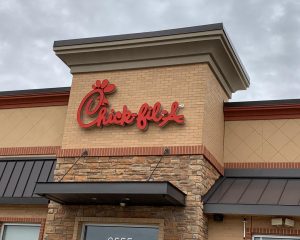Athletes experience ‘miracle recoveries’
Sophomore Taryn Knuth hits the ball after it was set to her by senior Kristen Stucker in a tournament on Oct. 21 at the high school.
December 17, 2014
Sophomore and varsity volleyball player Taryn Knuth tore her meniscus in her left knee just a couple weeks before the state volleyball tournament. “It was serious enough that they had to do surgery,” Knuth said. “The recovery time for my surgery was about four weeks and I had surgery about two weeks before state.”
Regardless of the typical recovery time of four weeks, Knuth and her parents looked at a two-week recovery plan, in hopes of her being able to play in the tournament. “I knew I wanted to play so I had to go to rehab a lot and work really hard to get my knee healed and back to the point where I could play again,” she said. “A lot of work went into my knee.”
She met with her physical therapist three-to-four times a week along with at doing more rehab at home. Knuth made it back to the state semi-finals against Bettendorf only two weeks following her surgery.
Not only was the timing of this injury unfortunate for Knuth, but for the whole team as well. “When we found out about Taryn, [the team was] a little shocked at first and then nervous as to how it would impact the team’s ability to meet their goals in the post-season,” volleyball coach Richard Brooks said. “I believe they responded really well and everyone picked-up their efforts.”
While being down one of their starting players, the team still pulled out a win against Ankeny in the quarter-finals, advancing to play against Bettendorf. Although Knuth had made a full recovery, she only had one practice before her first game. “The doctor would not release her if there was a concern,” Brooks said. “So we felt comfortable putting her back in the line-up and she performed well.”
Knuth was not the only fall athlete dealing with a similar situation; senior Josh Borwick knew the agony of an in-season injury all too well. In the middle of the cross country season, Borwick developed inflammation in his piriformis muscle, which is a muscle deep in the gluteus maximus. The piriformis is positioned next to the sciatic nerve, so when it is inflamed it can irritate the nerve, causing a lot of pain. An injury such as this varies in recovery time. “It is very frustrating because the healing process takes a lot of time and patience,” Borwick said. “And you can’t really do any running until the muscle has healed itself.“
Borwick recovered in just enough time to be back for the state meet. With only a week-and-a-half to practice before the meet, it was hardly any time. “In distance running, a-week-and-a-half isn’t nearly enough to make any significant improvement,” Borwick said. Fortunately, this injury was nothing new for him; having similar experiences in the past, he knew exactly what he needed to do. “I had gone through injuries before and I knew what to expect in the race,” Borwick said. “I knew I would be able to go out and race hard even though it would be a lot harder after taking a pretty long break from running.”
Just like Knuth, Borwick worked with specialists, trying to speed up recovery time and get back to running. “There were numerous strengthening exercises and stretching routines I did,” Borwick said. “I went to physical therapy multiple times to try and speed up the healing process.” After months without running, and in complete recovery mode, Borwick’s hard work to get back in the sport paid off. “A ton of work went in to coming back before state,” he said.
Athletes can sometimes be injured more if they return to their sport too soon. “In our profession we have guidelines that have a time frame associated with injuries and it pays respect to the healing time frames,” physical therapist James Laughlin said. “And that’s important.”
Trying to speed up standard recovery time can be a huge risk, but each case is different and depends on the individual. Ultimately it is the athlete’s choice as to when they want to return, regardless of general recovery times. Typically, those injuries can take anywhere from several weeks to several months to repair and then after that there is usually a ‘return to sport.’ This time period is an additional time frame before some one comes back to a sport, a time from several weeks to several months to get them back into total condition.
“It wouldn’t be my recommendation to return so suddenly,” Laughlin said. “But of course, each individual has a choice to do what they feel is best.”
Although there are students out there that have overcome these in-season injuries, there are also some who never did. Sophomore and varsity basketball player Morganne Grant tore her ACL in March of 2014 for the first time during a basketball tournament in her freshman year. This injury wrapped up the rest of the basketball season for her. Now, she finds herself in the same situation, tearing her ACL yet again early on in the season. Only having played one varsity game, it tore before she could play in her second game. “I got an MRI just to check on things,” Grant said.
The MRI showed that the ACL had a 80% tear in it, and the meniscus had a tear. “We thought it was just a scar tissue,” Grant said. “We had no idea that anything was tore. ” Unfortunately, for Grant, this is one injury that will not recover in time.
The recovery time for her injury takes at least six months, meaning she will not be back for the school season. “Basketball season had just started, I was just getting into the fast-paced practices, and just getting to the level of intensity that I wanted to be at,” Grant said. “I feel like its not real, like I’m still in shock.”
Grant will not be back playing again until May, at best. Even if she makes it back in May, she will only be able to play in club season because her varsity season will have already ended. “I’m anxious to get into recovery right after surgery and just try to bounce back as quickly as I can,” Grant said.





